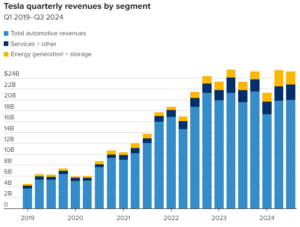Wednesday’s third-quarter results from Tesla exceeded analysts’ projections even as income came in just slightly below projections.
Based on a poll of analysts by LSEG, below is the company’s performance relative to what Wall Street was predicting:
Adjusted against 58 cents projected, earnings per share are 72 cents.
Revenue: $25.18 billion instead of the estimated $25.37 billion.
From $23.35 billion a year before, revenue rose 8% in the quarter. From $1.85 billion, or 53 cents a share, a year ago, net income shot to almost $2.17 billion, or 62 cents a share.
Automobile regulatory credit income of $739 million during the quarter strengthened profit margins. Every year, automakers have to pick up a set number of regulatory credits. Should they fall short of the target, they can buy credits from businesses like Tesla, whose surplus credits result from just electric vehicle manufacture.
They can get them from people with credits to sell by manufacturing electric, or “zero emissions,” vehicles. Since Tesla solely produces electric vehicles, the business has plenty of surplus regulatory credits and markets them for essentially a 100% profit.
From $19.63 billion in the same quarter a year before, automotive revenue rose 2% to $20 billion. While services and other revenue—which includes income from non-warranty repairs of Tesla vehicles—jumped 29% to $2.79 billion, energy generating and storage revenue rose 52% to $2.38 billion.
On October 22, Tesla claimed on a shareholder presentation that it had reached 7 million vehicles built and that, behind only the Model 3 and Model Y, its newest offering, the Cybertruck, became the third-best-selling totally electric vehicle in the United States. Tesla does not group sales according to model.
Based on estimates from Kelley Blue Book, Tesla sold more than 16,000 Cybertrucks in the United States in the third quarter even if its angular steel pickup has been beset with quality problems. The Cybertruck “achieved a positive gross margin for the first time,” Tesla added in the release.
Tesla stated third-quarter vehicle deliveries of 462,890 earlier this month. Deliveries are the closest approximation to sales Tesla reports. In the period ended Sept. 30, the business also reported manufacturing 469,796 electric automobiles.
Although deliveries climbed by 6% from a year ago, they fell short of analysts’ projections and followed two consecutive quarters of year-over-year reductions. To generate sales, Tesla has been providing a range of discounts and incentives.
“We expect to achieve slight increase in vehicle deliveries in 2024 despite continuous macroeconomic conditions,” the business stated on Wednesday’s earnings slide. The company also underlined its intention to “launcher” more reasonably priced cars during the first half of 2025.
Along with a new generation of automakers such Li Auto and Nio, Tesla is under more competitive pressure—especially in China—from companies like BYD and Geely. Though they are reversing past electrification pledges, major American automakers Ford and General Motors are beginning to market more electric vehicles.

Less than two weeks after a much-anticipated robotaxi event that left shareholders yearning more information, the earnings report arrives roughly two weeks before the presidential election, which has occupied a significant portion of CEO Elon Musk’s late campaign schedule.
Questions asked by investors on the Say Technologies online platform indicate that a lot of them want to know how Musk’s pro-Trump activity will affect Tesla and its stock price.
The stock was down 18% in October and headed for its worst month since January before Wednesday’s after-hours bounce. The Nasdaq is up 22% over that period; the shares dropped 14% for the year.
Though the previous president opposes the kinds of public expenditure on EVs, charging infrastructure, and environmental laws that have helped Tesla for years, Musk has spent tens of millions of dollars to get Trump back into the White House.
At a recent event in Harrisburg, Pennsylvania, Musk also declared that he believes many government institutions and rules in the United States to be superfluous and useless.

